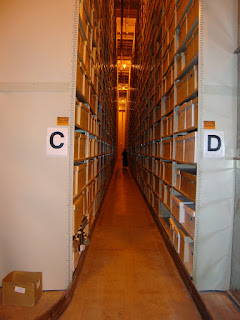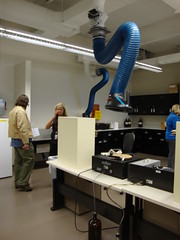Conservation has many areas of specialty- books, paper, photographs and costumes, as I mentioned, and also modern art, which can have all sorts of challenges because of modern art materials (e.g. acrylic paints) or common materials that are used in a new way thanks to the inspiration of an artist.
As I walk through an exhibit I often wonder how the conservator at that particular museum will approach the challenges presented by the artwork I am seeing. I recently saw the exhibit "Staged Stories: Renwick Craft Invitational 2009" at the Smithsonian's Renwick Gallery, and I was delighted by the work of Mark Newport a fiber artist who knits life, or larger-than-life sized super hero costumes out of acrylic yarn.


 As a knitter I was amazed by all the details of his work, noting his choices in how he did his armhole decreases or shaping to make a waist or legs for the cosutme. As a conservator, I
As a knitter I was amazed by all the details of his work, noting his choices in how he did his armhole decreases or shaping to make a waist or legs for the cosutme. As a conservator, I  wondered how my counterpart at the museum would face the choices regarding conservation of such a piece. For example, when housing a costume for storage, you want to fill the sleeves or torso or legs just enough to support the article of clothing in a shape similar to how it would be worn, but in the case of these superhero costumes, part of the artist's concept is that they are empty and hanging on the hanger, which would indicate a different approach, perhaps. And then how will this particular acrylic yarn do over time? What will be the approach for treatment of a tear in the fabric? At least with acrylic yarn there is little to fear from moths!
wondered how my counterpart at the museum would face the choices regarding conservation of such a piece. For example, when housing a costume for storage, you want to fill the sleeves or torso or legs just enough to support the article of clothing in a shape similar to how it would be worn, but in the case of these superhero costumes, part of the artist's concept is that they are empty and hanging on the hanger, which would indicate a different approach, perhaps. And then how will this particular acrylic yarn do over time? What will be the approach for treatment of a tear in the fabric? At least with acrylic yarn there is little to fear from moths!And while this may sound like a horrible inability to leave my work in the lab, it does offer me another level of wonder when I see an exhibit.



















